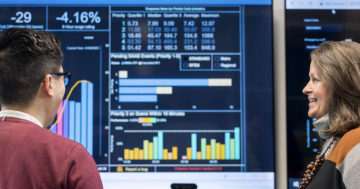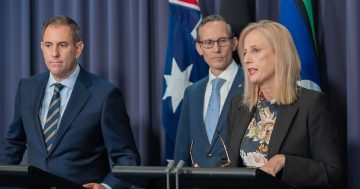Mia Hunt* convenes Public Servants from three continents to discuss how they are reshaping Government property portfolios and the mechanisms helping teams deliver in this new world of work spawned by the global pandemic.
 The COVID-19 pandemic proved an accelerator for scores of Government projects and programs, including progress towards modernising how and where Public Servants work.
The COVID-19 pandemic proved an accelerator for scores of Government projects and programs, including progress towards modernising how and where Public Servants work.
Now, Governments are taking stock of the lessons of the last three years and working to embed flexibility — but data on exactly what works and what doesn’t is hard to come by.
In this Global Government Forum webinar, leaders from Canada, the United States the European Commission and South Africa share insights into what they are doing to ensure Public Servants can do their best work in new ways.
Deputy Commissioner at the Public Buildings Service (PBS) of the US General Services Administration, Allison Heikens Azevedo, started by saying: “I think in this time, post pandemic, we’re dealing with probably the greatest opportunities, and also the greatest challenges”.
She gave an overview of the PBS’s work to right-size and reshape its portfolio.
The PBS is responsible for more than 8,700 buildings that are either owned or leased by the Federal Government and house 1.1 million Federal employees and contractors.
Its overarching objective is to enable people who work in Government buildings to deliver the missions of their respective Departments and Agencies through creating the right working environment equipped with the right technology.
“To do this, we must maintain relationships with key stakeholders including the Office of Management and Budget — which must be kept abreast of the funding requirements necessary to reshape the portfolio — and with industry partners “who deliver 90 per cent of the work we do,” Ms Heikens Azevedo said.”
“We must also work with communities to minimise the impact on surrounding businesses, given that many Feds have transitioned to hybrid working and are no longer in offices full time.”
Assistant Deputy Minister, Real Property Services at Public Services and Procurement Canada, Stéphan Déry shared details of the hybrid working model adopted in Canada and what it meant for the Public Service.
He said the Government had already started modernising its workplace to leverage the benefits of activity-based working and transitioning to a hybrid work model before the pandemic, but COVID-19 presented a strategic opportunity to accelerate this program.
Though there is no one-size-fits-all, Mr Déry highlighted that the Public Service believed a hybrid work model “is a practical way to offer employees flexibility and a better work-life balance”.
With this in mind, his Agency was focusing on designing spaces that supported activity-based working and “takes into consideration the value of working together in person to collaborate, innovate, build trust, and create a sense of community”.
He said this tied in with the move from “remote by necessity to hybrid by design”.
Chief Director of South Africa’s Department of Public Service and Administration, Emmanuel Kgomo emphasised that COVID-19 had not fundamentally changed the way public services were delivered or received, but had triggered progress towards easier access to Government services by citizens and businesses.
For a number of reasons — not least limited personal resources and connectivity — face-to-face remained the preferred means of access.
In terms of the Government workforce, the pandemic highlighted the need to increase remote working mechanisms.
Challenges around IT, connectivity and Departments having to prioritise spending in other areas rather than on technology, had hampered wholesale change.
However, Mr Kgomo said there have been “developments and opportunities”.
“Overall, the Government has better technological reach and has facilitated better interaction and communication between colleagues, enabling exchange of ideas and expertise and greater use of platforms such as Zoom and Microsoft Teams,” Mr Kgomo said.
He also said Public Service leaders were sceptical about colleagues working remotely due to difficulties monitoring and gauging productivity, and trust issues among co-workers.
Deputy Director General, HR Operations at the European Commission’s Directorate-General for Human Resources and Security, Christian Roques said the pandemic prompted a dramatic change in how the Commission’s employees work — and for the better.
He said the Commission, with 32,000 employees, attracted most of its workforce from the private sector.
It was formed primarily of expatriate officials from other countries. It must therefore be an attractive employer.
“COVID proved to be a trigger point for greater progress, spurred in part by the signing of the European Green Deal in 2020 which sets out an ambition to reduce carbon emissions by 60 per cent, Mr Roques said.
“We are looking to create a new HR strategy fit for the future that bakes in flexibility and the optimisation of building space.
He said before COVID hit, the Commission was renting huge conference centres where staff, stakeholders, experts from member States and others would meet — now a lot of that was done virtually.
The changes run deeper.
The Commission had a rigid system of people being present in the office for a certain number of hours every day “but we don’t measure presence in the office anymore… now it’s about output”.
“As a result of the move away from full-time office work, the Commission needs fewer offices than before. Now, the focus is on dynamic, collaborative spaces,” Mr Roques said.
“Hot desking has become the norm with people encouraged to use a booking tool to book space in any of the Commission’s offices depending on the project and team they’re working with at any given time.”
*Mia Hunt is a journalist and editor with a background in covering commercial property.
A fuller version of this article appears on the Global Government Forum website.











